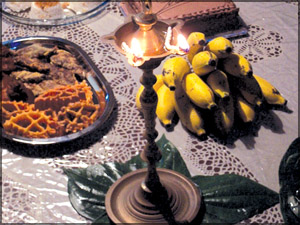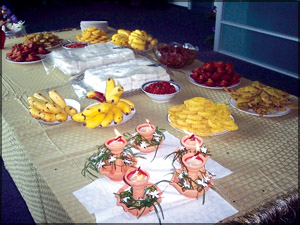Mouth-watering festive delicacies
The long-awaited day has finally come. The aroma of the sweetmeats
could be making your mouth water and increasing your hunger. From all
the auspicious activities connected to the New Year, one of the
children’s favourites is consuming the first meal.
 The Avurudu table is arranged with many sweetmeats along with milk
rice (kiribath) and bananas. Now, we are sure that you are dreaming
about all the sweetmeats that you will be eating within the next few
hours. The Avurudu table is arranged with many sweetmeats along with milk
rice (kiribath) and bananas. Now, we are sure that you are dreaming
about all the sweetmeats that you will be eating within the next few
hours.
All these days, your mother and grandmother may have prepared these
lovely things. Did you tell them what you would like too? Now, let’s
learn about some of our traditional sweetmeats!
As you all know, the first meal prepared at an auspicious time in the
New Year is milk rice, which could be eaten with either red chilli
sambol (known as katta sambol) or with jaggery. It can also be eaten
with the curry called hath maluwa which contains seven different
flavours as it is made with seven types of vegetables.
When we say Avurudu, the first thing that comes to our mind is kavum
(oil cakes); the next is kokis. Can you even think of a new year without
kavum and kokis?
Let us check out the sweetmeats people make for the Sinhala and Hindu
New Year. Normally, the Aluth Avurudu table is laid with kiribath, kavum,
kokis, athiraha, aasmee, aluwa, mun aluwa and various other traditional
sweets. Never forgotten are the ripe plantains too.
According to our ancestors, kavum should be prepared by the housewife
or women of the family; and not bought from outside, the way it is done
today by most people, due to convenience.
During the era of kings, all higher officers had to bring the king
gifts for the New Year. Among those gift items was kavum.
Since oilcakes or kavum is one of the major traditional sweetmeats we
make during the New Year, we’ll give you some interesting information
about oilcakes, such as the different varieties, how they are prepared,
and beliefs connected to oilcakes.
 Oilcakes are generally prepared using rice flour mixed with treacle
and fried in coconut oil. Oilcakes are generally prepared using rice flour mixed with treacle
and fried in coconut oil.
After pouring the batter for oilcake into a piping-hot pan of oil,
the shape of the konde (a woman’s knotted hair) is taken using a thick
spike or an ekel. Oilcakes are taken out from the pan when it becomes
golden in colour. This needs much skill.
There was a belief in the past that if we eat hot kavum just out from
the pan, the evil spirits will come to our soul, and also that if we
keep a pot of water by the side of the pan with boiling oil, less oil
will be burnt.
Unbelievably, 18 kinds of kavum were made in the past! Some of them
were: handi kavum (oilcakes made using spoons), mun aluwa (kavum made
with green gram flour), ulundu kavum (kavum made with ulundu flour),
utupu (kavum made with a coconut shell), and the most popular variety,
konda kavum, the upper part of which resembles the knot of hair, naran
kavum (which takes the size and shape of a mandarine), undu kavum and
diya kavum (liquid food made for people who cannot digest solids).
Garuppu kavum is a variety that came after the arrival of the Europeans.
As the name implies, this is made using a fork. The rarest variety in
the modern world is pana kavum. This is made of scum (floating matter on
liquid or waste part of anything). It took the shape of a comb. However,
kavum is not the only sweetmeat we make for the New Year.
Have you eaten athiraha? It is believed that this sweetmeat was thus
named because it was very tasty. Asmi is another traditional sweetmeat,
in the shape of string hoppers, dipped in treacle. The name Asmi was not
only used to describe the sweet, but also applied to a similar white
nest built by wasps.
Aggala was often taken by villagers when they went on long
pilgrimages to Sri Pada. It is a sweet that is easily preserved and thus
people made aggala as it could be kept for long periods. Today it is
also served as an Avurudu delicacy.
What we have featured upto now are all Sinhala sweets. Now we will
see what our Hindu friends prepare for the festival. They make a special
dish called Maanga Pachadi. This dish is made of raw mangoes, jaggery
and neem flowers.
It has a sweet, sour and bitter flavour. This signifies the different
aspects of life. Another meal they make is Pongal. They make it as a
thanksgiving to the Sun God. This is sweet rice made with new red rice,
jaggery, cashew nuts, ghee and plums.
Young or old, most people really love eating these sweetmeats,
because they are not only delicious, but are also nutritious, as they
are blended with indigenous food.
-Janani Amarasekara
|
